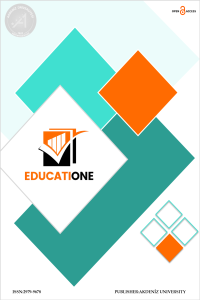Uzaktan Eğitim Sistemi ile İşlenen Ses Eğitimi Derslerinin Yeterliği Hakkındaki Öğrenci Görüşlerinin İncelenmesi
Müzik, Müzik Eğitimi, Pandemi, Ses Eğitimi, Uzaktan Eğitim
Research of Student Opinions on the Qualification of Voice Education Lessons Taught by Distance Education System
Music, Music Education, Pandemic, Distance Education,
___
- Aydemir, Ö., (2011). Yükseköğretimimizde uzaktan eğitim. Yükseköğretim ve Bilim Dergisi, 1(2), 69-71. https://dergipark.org.tr/tr/pub/higheredusci/issue/61475/917977
- Blake J. (2018) Distance learning music education: An overview of history, literature, and current trends. Journal of Online Higher Education, 2(3), 1-22.
- Ekiz, D. (2015). Bilimsel araştırma yöntemleri. Anı Yayıncılık.
- Groulx, T., & Hernely, P. (2010). Online master’s degrees in music education: The growing pains of a tool to reach a larger community, 28(2), 60-70. https://www.learntechlib.org/p/65082/
- Gunawardene, N., & Lapointe, D. (2007). Cultural dynamics of online learning. In Moore, G. M., (2. Eds.), Handbook of Distance Education, (pp 593-607). Lawrence Erlbaum Associates, Inc., Publishers.
- Haught, D., (2011). Technology in schools: Changing teaching and learning. In Duffy, J., & Mcdonald, J, (4. Eds.), Teaching and Learning with Technology (pp 316-388). Pearson.
- İşman, A. (2011). Uzaktan eğitim. PegemA Yayıncılık.
- Kaya, Z. (2002). Uzaktan eğitim. PegemA Yayıncılık.
- Kruse, B., Harlos, C., Callahan, M., & Herring, L. (2013). Skype music lesson in the academy: intersections of music education, applied music and technology. Journal of Music Technology & Education, 6(1), 43-60. https://doi.org/10.1386/jmte.6.1.43_1
- Levendoğlu, N. O., (2004, Nisan 7-10). Teknoloji destekli çağdaş müzik eğitimi, (1924-2004 Musiki Muallim Mektebinden Günümüze Müzik Öğretmeni Yetiştirme Sempozyumu Bildirisi), https://www.muzikegitimcileri.net/bilimsel/bildiri/O-Levendoglu.pdf, Isparta.
- Sağer, T., Eden, A. ve Şallıel, O. (2014). Müzik eğitiminde uzaktan eğitim ve orkestra uygulamaları. İnönü Üniversitesi Sanat ve Tasarım Dergisi, 4(9), 69-79. https://dergipark.org.tr/tr/pub/iujad/issue/8728/108995
- Sarıkaya, M. (2021). Pandemi sürecinde uzaktan eğitimi ilişkin müzik eğitimi ana bilim dalı öğrencilerinin görüşleri. Atatürk Üniversitesi Güzel Sanatlar Enstitüsü Dergisi, 27(46), 92-100. https://doi.org/10.32547/ataunigsed.835720
- Tecimer, B., (2006). İnternet ve Yaşam Boyu Müzik Eğitimi, https://www.muzikegitimcileri.net/bilimsel/makale/B-Tecimer12.pdf, 15, 8-9.
- Thornton, L. (2020). Music education at a distance. Journal of Music Teacher Education, 29(3), 3-6. https://doi.org/10.1177/1057083720928615 Yıldırım, A., Şimşek, H. (2008). Sosyal bilimlerde nitel araştırma yöntemleri. Seçkin Yayınevi.
- YÖK. (2022, Kasım 14). Yükseköğretim Kurulu. yok.gov.tr: https://covid19.yok.gov.tr/Documents/anketler/ogrenci-ank
- Yayın Aralığı: Yılda 2 Sayı
- Başlangıç: 2018
- Yayıncı: Akdeniz Üniversitesi
Özgürlük okulu: Çocuk Yetiştirme Konusunda Köktenci Bir Yaklaşım (Alexander Sutherland Neill)
Eleştirel Düşünme Etkinlikleri ile Değerler Eğitimi
COVID-19 Tedbirleri Sürecinde Öğrencilerin Tıbbi İngilizce Dersine Katılımı ile ilgili Düşünceleri
Beden Eğitimi ve Spor Dersi Öğretmenlerinin Eğitim Yöneticiliğine İlişkin Görüşleri
Doğadaki Son Çocuk Adlı Kitabın İncelenmesi
Recep DÜNDAR, Mehmet Mustafa KIZIK
Kültürlerarası İletişim Bağlamında Alan Dili Olarak Havaalanı Dili: Freeshop Örneği
Okul Kültürü Tanılamaya Dair Bir Durum Çalışması
Ramazan Burak KAHYAOĞLU, Gürol GÜVEN, Mehmet ATİK, Muhammet Ali ÇİLOĞLU, Dilay AKTAŞ GÖNEN, Filiz ÖZLÜ, Safiye ÖZLÜ
Seda ESKİDEMİR MERAL, Fatma TUTKUN YAŞAR, Leyla Şebnem GÜL YILDIRIMOĞLU
